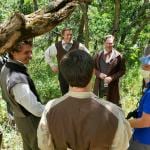
The reviews of Six Days in August continue to roll in from The Usual Suspects. And, of course, they’re all negative — and, also of course, none of the reviewers has actually seen it. (Who says there’s no such thing as prophecy?) The film is shallow and dishonest propaganda, plodding and dull, a whitewashed pseudo-history, embarrassing and amateurish, with a stilted and pretentious script, and already, months before its final completion (to say nothing of its scheduled theatrical release), a complete failure at the box-office.
I just thought that you should know.
The same folks knew, long before it was released, that our 2021 movie, Witnesses, wouldn’t mention the failure of the Kirtland Bank and would avoid any mention of early Latter-day Saint plural marriage. Oops.

(Wikimedia Commons public domain image)
Yesterday evening, I read John Gee, “Ten Views on the Falling Away,” BYU Studies 63/2 (2024): 139-176. He is responding to recent revisionist interpretations, by a handful of Latter-day Saint scholars, of the Latter-day Saint concept of a “Great Apostasy.” These attempted reinterpretations, I think, are principally motivated by a commendable sympathy for, and appreciation of, the accomplishments and the virtues of our fellow Christians today and, yes, during the period between the death of the ancient apostles and the Restoration. I share that sympathy and admiration. Nevertheless, with Professor Gee, I do not favor backing away altogether from the historic Latter-day Saint view of a cataclysmic falling away. Here is a portion of the conclusion of his article:
An examination of the primary sources . . . shows that the early Christians were aware of a loss of authority that coincided with a loss of the Apostles. There was a rebellion (apostasy) against that authority and the teachings of the Church. It was prophesied by Jesus and the other New Testament writers. By the end of the century, Christian writers such as Clement and Ignatius described an Apostasy occurring. Early second-century writers like Hegessipus testified that it had occurred, and even Irenaeus in the second half of the second century testified that the Apostasy had taken place.
The fact of the Apostasy does not mean that everyone afterward who did the best that they could without authority or revelation was evil, or that there is nothing good to be found in those times. We need neither turn them into heroes nor villains; we could treat them as human beings while recognizing that they were to use the Book of Mormon’s phrase—in “that awful state of blindness” (1 Ne. 13:32).
There is no intellectual reason to reject or change the teachings of The Church of Jesus Christ of Latter- day Saints with respect to the falling away. They are intellectually defensible and account for the early Christian evidence as well as, or better than, any other theories. (176)

(Wikimedia CC public domain)
In the same issue of BYU Studies, I also read Richard E. Turley Jr., “Lessons We Can Learn from the Mountain Meadows Massacre” (129-137).
Richard E. Turley Jr. is the former Managing Director of the Church History, Family
History, Public Affairs, and Communication Departments of The Church of Jesus Christ of Latter- day Saints. He also served as Assistant Church Historian and Recorder. The author of numerous books on Latter- day Saint history, he was recently commissioned by the Church’s First Presidency to write a biography of the Church’s founding prophet, Joseph Smith Jr.
I have long imagined giving a devotional fireside or even a talk in sacrament reflecting on the Mountain Meadows Massacre, which has long seemed to me to offer elements of a Greek tragedy — for the perpetrators of the atrocity as well as for its victims — and powerful moral lessons. So my attention was naturally caught by Brother Turley’s title. (He is, I would think, the preeminent living expert on the tragedy at Mountain Meadows.) My approach would be significantly different from his, but I very much appreciate what he has written. I quote here his closing paragraph:
No one alive today is responsible for the Mountain Meadows Massacre. But we are all responsible for how we deal with it, including learning from the lessons it teaches. Let us never deny or condone the massacre or try to excuse those who took part. Rather, let us resolve to (1) avoid fanaticism, (2) not overreact to rumors, (3) not give in to peer pressure, (4) find safety in councils, (5) not try to cover up wrongdoing, (6) deal with hard topics honestly, and (7) love anyone we might be tempted to view as an enemy. (137)
In his article, Brother Turley offers multiple examples where those who perpetrated the Mountain Meadows Massacre failed to abide by the principles that he sets forth in that concluding passage.
And here’s a horror story from the Deseret News that further illustrates the sort of thing that can happen when Brother Turley’s rules are ignored. By the way, it’s possible, although not certain, that Ray Epps is a Latter-day Saint; certain clues seem to hint at it. I mention that fact not because he would be any more or less deserving of understanding and sympathy as a member of the Church but simply because some readers of this blog might more easily identify with him if he is: “The undercover agent who wasn’t: Ray Epps believed the conspiracy theory that the 2020 election was stolen. Then he became the conspiracy theorists’ biggest target.”
The latest of the Interpreter Foundation’s very short video features, drawn from the docudrama Undaunted: Witnesses of the Book of Mormon, has now gone up. It is entitled “In the Spirit,” and it features Terryl Givens.
We encourage you to watch it — it is, truly, very short — and, if you feel so inclined, to pass it on further.
Posted from Depoe Bay, Oregon

















